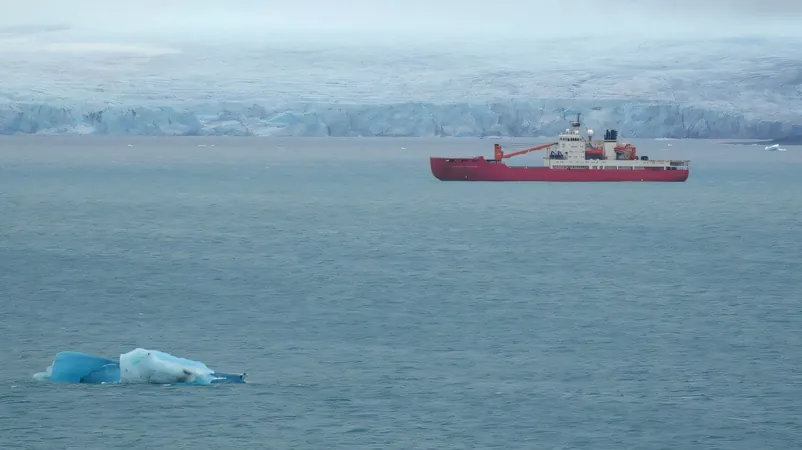
Groundbreaking Research Reveals the Hidden Secrets of Sea Spray Aerosols in the Arctic!
2024-11-27
Author: Wei Ling
Groundbreaking Research Reveals the Hidden Secrets of Sea Spray Aerosols in the Arctic!
A groundbreaking research initiative led by scientists from the École polytechnique fédérale de Lausanne (EPFL) has unveiled a novel system that sheds light on the intricate relationship between sea spray aerosols, ocean states, and atmospheric conditions. Mounted on an icebreaker, this cutting-edge technology journeyed across the unforgiving Arctic waters to gather and analyze crucial environmental data.
Aerosols—tiny airborne particles—are essential players in the Earth's climate system, influencing cloud formation, rainfall, and solar radiation reflection back into space. Understanding the quantitative aspects of these aerosols is vital for enhancing the accuracy of weather forecasts and predicting climate change. Depending on their characteristics, aerosols can either cool or warm the atmosphere, adding layers of complexity to the Earth's energy dynamics.
With oceans covering over 70% of our planet, it's no surprise that sea spray aerosols are among the most significant natural contributors to our radiation balance. Yet, as noted by EPFL's Professor Julia Schmale, the precise quantity of these aerosols remains poorly understood, introducing considerable uncertainty in current climate models.
Revolutionizing Data Collection at Sea
The research team devised an innovative system to link sea spray aerosol concentrations to varying ocean states using commercially available cameras. This low-cost, user-friendly system is designed for deployment on various vessels, allowing for continuous data collection across different marine environments.
During the inaugural mission aboard an icebreaker in the challenging waters of the Barents and Kara Seas near the North Pole, the scientists gathered vital data. With climate change causing rapid ice melt and increased open water areas in the Arctic, the formation of sea spray aerosols has become increasingly unpredictable. "In this region, the dynamics are changing fast, and we anticipate major fluctuations in aerosol production," explained Schmale.
Traditionally, most aerosol data is obtained from satellites or coastal observatories, which only provide a partial understanding. By installing two standard cameras on the ship’s deck, researchers captured stereoscopic views that enabled them to create 3D images of wave conditions, significantly enhancing data richness.
Unlocking the Mysteries of Aerosol Production
The scientists' analysis from this initial expedition is revealing how various physical factors—like sea state, wind speed, and atmospheric stability—impact sea spray aerosol generation in the Arctic summer. Their findings confirmed an expected correlation: higher aerosol emissions occur with reduced ice coverage. Conversely, compact ice obstructs aerosol production.
Moreover, the study highlighted the influence of the marine boundary layer's stability on aerosol concentrations. This atmospheric layer, particularly turbulent near the water's surface, plays a crucial role in aerosol dynamics. The research team successfully developed predictive formulas for estimating aerosol levels based on combined observations of wave characteristics and atmospheric data.
A Path Towards Climate Model Integration
The implications of this research are monumental. "Our findings could enhance the integration of sea spray aerosols into climate models significantly," says Schmale, emphasizing the necessity for further studies across different oceanic regions. Climate conditions are notoriously variable depending on geographic location and season, emphasizing the need for a diverse data set.
In particular, results obtained from the Arctic cannot be directly applied to the Antarctic due to distinct atmospheric conditions, such as increased wind speeds in those regions. Yet, the potential for this low-cost system to be adapted and deployed on numerous research vessels worldwide is an exciting prospect for advancing our understanding of climate systems on a global scale.
As climate scientists race against time to understand and combat the impacts of climate change, this pioneering research serves as a beacon of hope, paving the way for more accurate climate predictions and ultimately, a better-informed global response to rising temperatures. Stay tuned as these scientists continue to unlock the secrets of our planet’s ever-changing atmosphere!




 Brasil (PT)
Brasil (PT)
 Canada (EN)
Canada (EN)
 Chile (ES)
Chile (ES)
 España (ES)
España (ES)
 France (FR)
France (FR)
 Hong Kong (EN)
Hong Kong (EN)
 Italia (IT)
Italia (IT)
 日本 (JA)
日本 (JA)
 Magyarország (HU)
Magyarország (HU)
 Norge (NO)
Norge (NO)
 Polska (PL)
Polska (PL)
 Schweiz (DE)
Schweiz (DE)
 Singapore (EN)
Singapore (EN)
 Sverige (SV)
Sverige (SV)
 Suomi (FI)
Suomi (FI)
 Türkiye (TR)
Türkiye (TR)